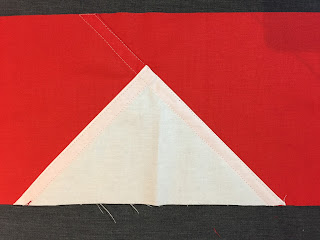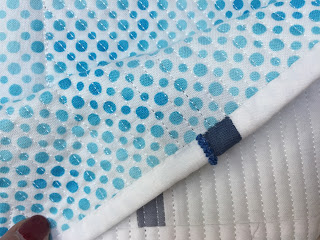I was honored when Amy Friend
(During Quiet Time) asked me if I would create something with her new
Improv fabric line by Benartex. I wanted to do something unexpected, knowing that I was also under a bit of a deadline. After receiving my Improv fabric my original idea flew out the window. The fabric patterns I chose are modern prints but also read as solids from a distance. That alone solidified the idea that became my project. I did need one other ingredient.
I high tailed it over to
Denver Fabrics and after much deliberation, purchased a lovely Italian 100% merino wool; a gray and cream herringbone. Not going to lie, it was expensive, but incredibly soft, light weight and will be very warm. I chose this particular wool because it was the perfect compliment to my selection of colors from Amy's gorgeous Improv fabric line. My Improv palette is decidedly feminine with raspberry, lime and shades of gray with the dominant print reading as white/off-white. The contrast of a lovely, soft wool with the fresh, feminine prints was exactly what I wanted.
I chose as my project, a car quilt- the perfect hybrid of both quilt and blanket. (My husband smiled at this- the irony of making a hybrid car quilt specifically for my hybrid car was not lost on him). This quilt is modern and fun while also being soft and warm. To make the perfect modern car quilt you need 2 things: a fun pieced modern quilt top design made with Improv cotton fabric (one side) and soft and warm merino wool on the reverse.
The pieced cotton top is simple and bold, showcasing 9 of the fabrics from the Improv line: (from left to right) Patches (White/light gray), Twisted Screen (Citron), Beans Crosshatch (Citron), Molehills (Citron), Triangle Toss (Deep Rose), Patches (Rose), Triangle toss (dark Gray), Twisted Screen (Gray), Beans Crosshatch (Gray)
Simple, straight line hand quilting was accomplished with 6 different colors and 2 different types of thread keeping the inherent softness and drape of this quilt. Most of the thread is
12 wt Sulky 100% cotton quilting thread in off white, 3 different light to medium grays and one pale celery green. The 6th thread is
Coats and Clark retroreflective Signal Thread (large cone in photo below). This last thread is a strategic addition to this quilt. The inherent reflective qualities of this tread combined with the fabrics make this quilt not only warm but also safe.
Any light (say incoming headlights) bouncing off the quilt will immediately make the quilt visible in the dark. Depending on the circumstances, this quilt could save your life. (That's the best endorsement for making a car quilt, in my opinion).
Before going into the nitty-gritty remember this is a week long blog-hop. Here is the line-up.
The hybrid Car Quilt details:
"Along for the Ride"
 |
Soft and wrinkly after washing.
The top and bottom fringe are a nod to its "blanket" roots. |
60" x 60"
Top: Original design, pieced top using 100% cotton "Improv" Fabric by Amy Friend for Benartex.
Back: 100% Italian wool, pre-washed (see notes below) and fringed.
 |
| Because the wool has loft, nearly all of the stitching is invisible on the back. |
Hand quilted, from the back (using the herringbone's linear registration lines as guide lines for the hand-quilting), using cotton and reflective threads.
 |
The retroreflective Signal thread reads "white" ( photo taken with flash on).
The thread is light gray in daylight. |
Machine washable, line dry.
Think about making one of your own? I'm certain that many of us have the necessary materials already in our sewing rooms.
A (not really a tutorial)
Tutorial:
Materials:
1. A finished quilt top made with soft and beautiful Improv fabric. This fabric is versatile and a perfect choice for many patterns including one of your own making. If you keep your car quilt to 60" x 60", fitting the backing fabric will be easy, especially since most garment wools are 60" wide. For my top, I used the 3 gray FQ's for the left side and 1 1/2 yards of the white/off-white fabric for the remainder of the top. Sewing the FQ along their short side made a pieced section the same length as the single piece of Patches (white/light-gray). I then drew 3 elongated oval templates and traced them on the quilt top as shown in the overall photo. Using the
technique discussed here in an earlier blog post, I added the 3 greens in descending color intensity (using a FQ of each color). Finally, I used the same smallest oval template to add the 2 raspberry highlights. This quilt has only 14 seams on the top, and can easily be pieced in a day.
2. Backing of your choosing, keeping in mind natural fibers like wool shrink when washed. The backing doesn't have to be merino wool, it could be cashmere, or fleece. A woven wool makes lovely fringe, but a boiled wool would also work. Selecting a natural fiber for the back that is durable and warm is the whole idea behind this hybrid car quilt, as the backing fabric takes the place of the batting and cotton backing of a traditional quilt.
3. Sewing machine, thread, scissors, misc. sewing supplies.
4. Wash and dry your backing especially if your using a natural fiber like wool. You can block your wool, after washing to square, paying special attention to the parallel finished edges.
5. Trim square the 2 cut edges on each end of your backing fabric.
6. Stitch 1" from each cut edge and then gently unpick the weave to create fringe. If you don't want fringe you can skip this step, but I think the fringe really makes this the hybrid quilt/blanket that you'd want for your car.
7. Lay the back out on a flat surface, wrong side up and lay the top over the back, right side up.
8. Pin baste.
9. As carefully as possible fold under the raw edges of the top so that it covers the back, leaving just a little of the finished edges and all of the fringe, pin with straight (garment) pins.
10. Stitch top to back along outer edges, removing straight pins as you go.
11. Hand quilt or tie your top to the back to retain softness and drape with thread of your choosing. There are some wonderful specialty threads out there including wool, glow in the dark, solar reactive and retroreflective. Think of all the fun you can have just figuring out what thread to use.
12. IF you decide to quilt your car quilt by machine, lengthen your stitch and use a walking foot. Skip steps 9 and 10 above and start by quilting top to back leaving at least 1" of all the outer edges un-quilted. Tuck in the raw edges of the top after trimming to size and then complete step 10. If you have chosen a simple linear quilting design like me, the edge stitching, anchoring the side edges of the top and the back, will compliment the overall design eliminating the need to go back and finish any further machine quilting.
I can't think of a better was to finish this post than with a generous give away by Benartex celebrating this new and lovely Improv fabric line by Amy Friend.
GIVEAWAY:
- One winner will receive a curated fat quarter bundle of a selection of some on the prints in the Improv fabric line. Each blogger is giving away a FQ bundle, so please make sure to visit each and follow their rules for eligibility.
- To be entered to win, you need to leave a comment here on my blog. Tell me the one thing in your car you couldn't do without.
- The giveaway is open till July 14th at midnight. Winner chosen at random on July 15th and announced here and on IG (@spontaneousthreads)
- If you comment make sure I can contact you if you win. Failure to do so will result in another person being chosen as a winner. If you are a no-reply blogger please your email address and IG handle in your comment.
- Anyone can comment, but only US residents can win.
Note:
**** I purchased 6" more wool than the finished size for my final project. Because car quilts get dirty and need to be washed , I pre-washed and air dried the wool fabric to guarantee that I wouldn't have to commit to a future of dry-cleaning. It's risky doing this with dry clean only fabric, but I've done it in the past with success- this time, I lost about 4" overall due to shrinkage. If you want to consider something other than wool for the back, keep in mind that it's hand will affect the drape and warmth of the overall design. There are no wrong choices!
If using a woven wool, after the wool fabric dried, it was squared up and I carefully stitched a tight straight line 1" from each cut edge and picked out the cross woven gray fabric to create cream fringe.



















































